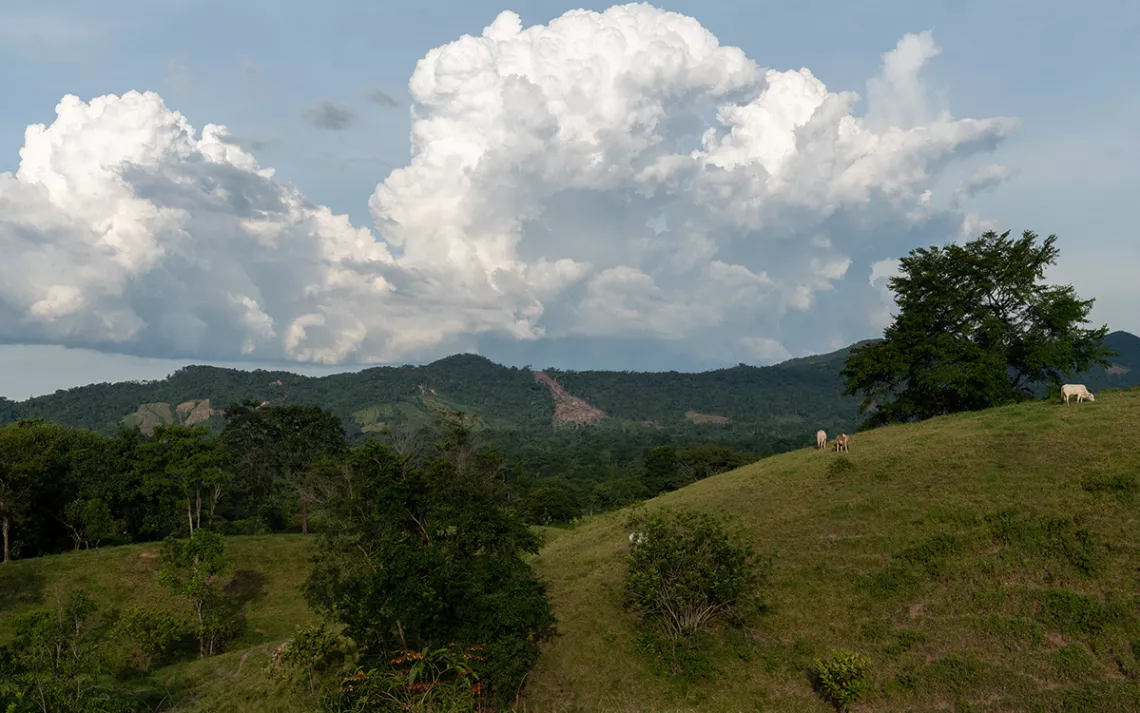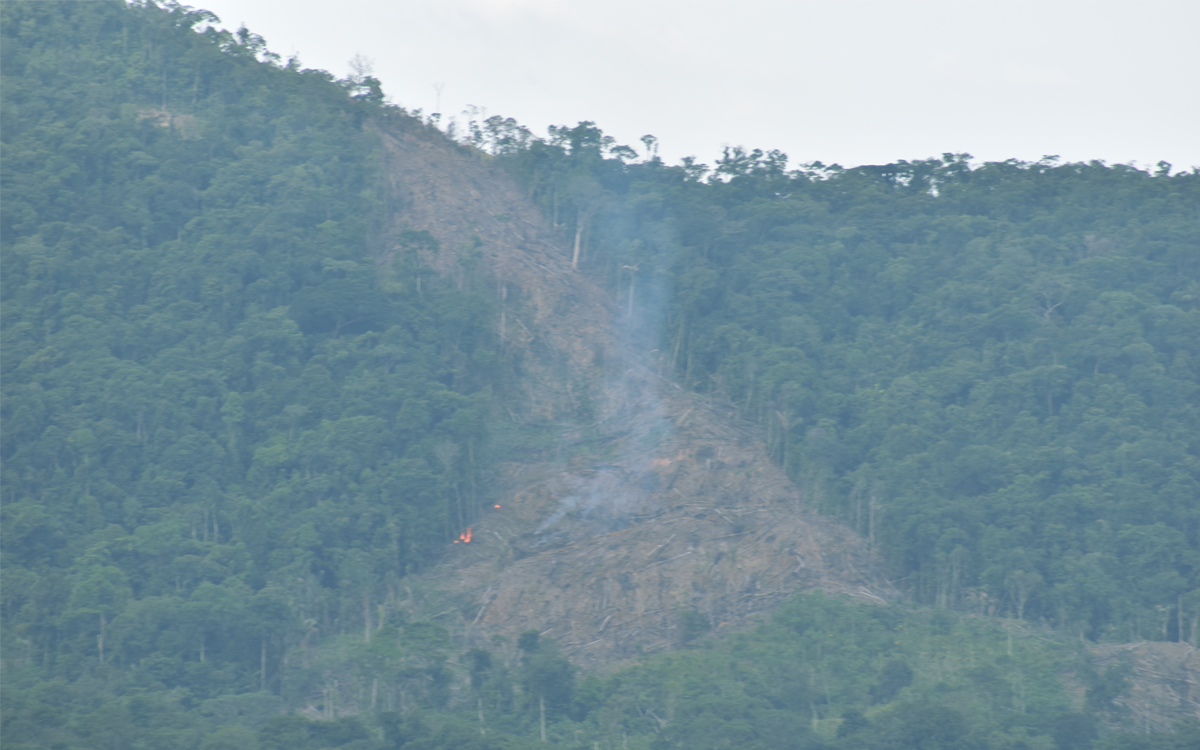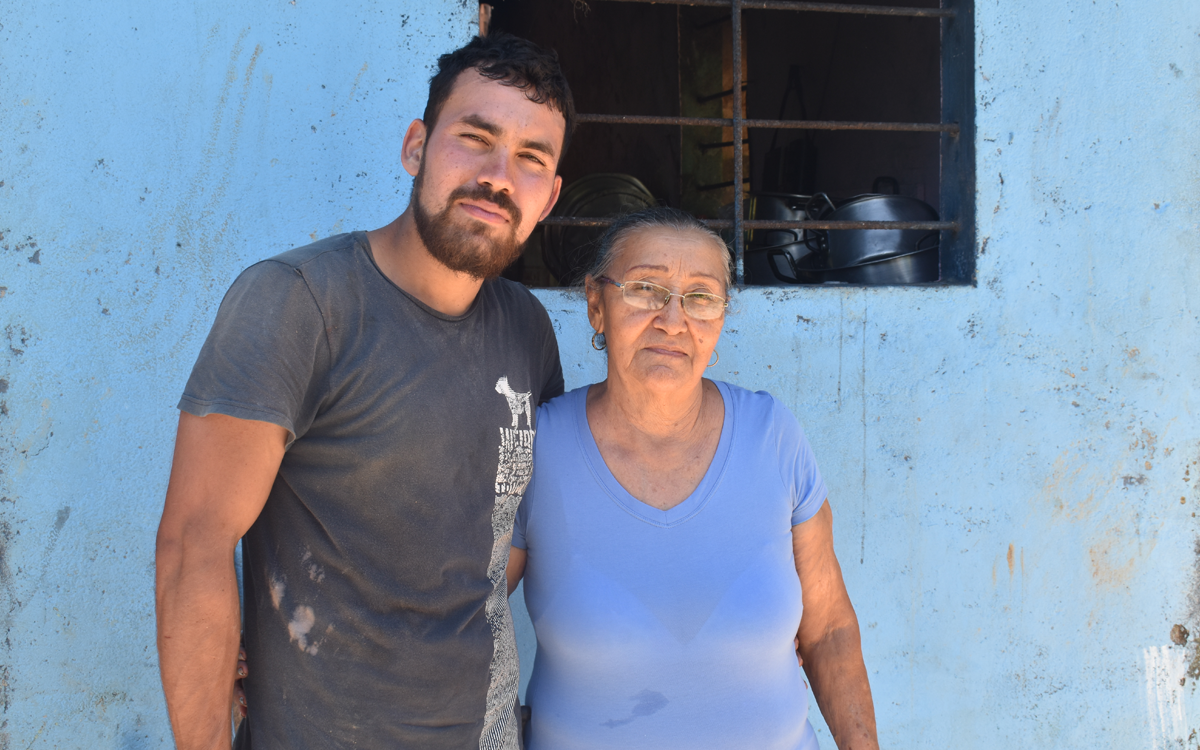Fires in the Jungle: Coca Production and Deforestation Accelerate in Colombia
Coca growers increasingly displace Indigenous communities

Forestland cleared to plant coca fields in Puerto Lajas, Catatumbo, Colombia. | Photo by Jordan Stern
Puerto Lajas, Colombia Andrés Silva Rojas pointed to a burning ridgeline of Andean forest in the distance. Black smoke billowed up into misty clouds, obscuring the peak of the mountaintop. “You see that ridge?” he asked. “In a week or two that will be a coca field. When I was a child, this was all jungle.” He waved at thousands of acres of coca fields stretching to the mountains.
Silva Rojas is a community leader who works with coca growers unions to promote sustainable farming practices in Catatumbo, in eastern Colombia near the Venezuelan border. Catatumbo is one of the biggest producers of coca—the raw ingredient used to make cocaine—in the world. Colombia produced record amounts of cocaine in 2020, according to the United Nations Office on Drugs and Crime (UNODC), and now accounts for over 80 percent of the world's global supply.
As a result, coca-growing regions in Colombia are experiencing a surge of deforestation. The country lost over 290,000 acres of forest in 2020 according to a recent government study. Amazonian rainforest regions were the most heavily hit, with some experiencing more than a 35 percent increase in deforestation compared with the previous year.
Coca is not the only cause of deforestation in Colombia. Cattle ranching, illegal mining, and industrial development are also factors. But coca cultivation is hitting Indigenous communities particularly hard. As growers move into ever more remote regions of Colombian rainforests in search of new fields to work, they are not only destroying fragile ecosystems but also threatening Indigenous communities who live there.
In Meta, a region in southern Colombia in the Amazonian region, the Nukak Makú people, a community that has lived in the rainforest for thousands of years, is on the verge of cultural and physical extinction.
The Nukak Makú people first made contact with Colombian society in 1988, when 43 members sought help from a nearby town after influenza, a disease they had never before encountered, killed almost half their population. The Colombian government declared Nukak Makú’s ancestral lands a reserve and prohibited agricultural development as well as commercial contact in an effort to prevent similar occurrences in the future.
But during Colombia’s civil war, encroachment by the Revolutionary Armed forces of Colombia (FARC) and illegal land grabs by palm farmers nearly brought the community to extinction. Now, the Nukak Makú face a new threat—their reserve has been encroached upon by coca farmers, which leaves advocates alarmed not only about territory loss but also a potential health crisis in a community that has very likely not been exposed to COVID.

Farmers burn down a rainforest on a mountain ridge to plant coca fields. | Photo by Joshua Collins

Andrés Silva Rojas, who works with local coca farmers unions to promote sustainable farming practices, with his grandmother Carmen. | Photo by Joshua Collins
In Catatumbo, National Park Barí, a legally protected reserve named after the Indigenous community that originally inhabited the region, is being encroached upon by splinter factions of both left- and right-wing armed groups who battle for control of the region as well as farmers seeking new land for coca cultivation.
These groups are the ideological descendants of paramilitary forces that evolved during Colombia’s 50-year civil war—which ended, at least officially, in 2017, when the government signed a peace deal with FARC. Coca farmers must pay "taxes" to whichever armed group controls the area where they live.
The Colombian government estimates that 22 percent of deforestation occurring in Colombia is a result of coca cultivation, but Silva Rojas says the true figure is much higher.
“Forest is burned to make room for coca,” he told Sierra, “and that’s what the government is measuring, but it’s not the full story.” As coca growers move into the lands of the Barí, they create secondary deforestation by building poorly planned roads that are little more than muddy paths through the mountains and which create erosion and flooding. They also clear areas near the coca fields for living and logistics and use powerful industrial pesticides to destroy secondary growth around the cultivation areas.
“In Catatumbo at least,” Silva Rojas continued, “I’d say that figure is closer to 80 or 90 percent.”
Farmers in Catatumbo, like nearly all of the regions where deforestation is rampant, often lack any other economic options than to plant coca. The region is virtually stateless and has been long ignored by a government that has failed to build even basic infrastructure or encourage more sustainable agriculture.
“There is nowhere to sell regular crops,” said Jorge, a coca farmer who asked that his last name be withheld for security reasons. “The government doesn’t even build roads here. It’s 11 hours to the closest city, but if you grow coca, the buyers will come to you.”
A vicious cycle of land grabbing, violence, instability, and deforestation has evolved in Colombian conflict zones, where residents say the country’s 50-year civil war never truly ended. Communities that embrace coca production attract the attention of armed narco groups, which bring violence along with their black market trade. The resulting instability makes the development of other economic options more difficult, and when the government attacks these groups, they push deeper into more remote regions of the country.
When the government does show up, it’s not to help the farmers but to punish them.
“The only time we see the government here is when they come to burn down our fields,” said Jorge.
Farmers get caught in the crosshairs between various paramilitary narco groups and the government in the drug wars that have raged for decades.
Juan Roberto Pueblo, of the Hitnu people, lives in Arauca in the southeast of the country. His community lost their ancestral lands in 2015 when rebel fighters from the National Liberation Army (ELN) arrived.
“When the guerrilla arrived, we were given a choice,” he said. “We could leave our homeland, we could grow coca, or we could be shot.”
Some of the community decided to stay rather than flee the lands they had lived on for thousands of years. Jorge was working in coca fields alongside his brother and other members of his tribe the day that Colombian soldiers arrived.
"The helicopters landed, and the soldiers came out shooting," he says. "We weren't guerillas. The guerillas had taken our lands. Then the military came to kill us."
Juan Roberto's brother died in his arms after being shot by the Colombian military during an anti-rebel drug operation in 2015, at the height of Plan Colombia, a decade-long anti-drug program financed by the United States. The Hitnu people fled their lands after that incident and have lived in a tent city in Arauca for over six years. They were promised their lands back as part of the peace deal that ended the war, but five years after the accord, they still wait in exile.
President Iván Duque’s administration has overseen more deforestation than that of any other president in Colombian history, according to figures published by his own government, and the rate of forestland loss has continued to grow each year of his administration. Colombia ranked sixth in the world in 2020 in forest loss according to data from the University of Maryland available at Global Forest Watch.
Duque has promised repeatedly to address the problem of deforestation, most recently at COP26 in Glasgow. While attending the UN Climate conference, Duque reaffirmed Colombian commitments to work toward a more sustainable future, stating in his speech that the country has put in place “clear goals such as planting 180 million trees, expanding protected areas, reducing 51 percent of CO2 emissions by 2030, and being carbon neutral by 2050.”
Silva Rojas has heard promises like that before. “The people have learned that they can’t trust the government,” he said, squinting at the smoke that had just begun to clear on the distant ridgeline. “Until politicians in Colombia become more interested in solutions than bullets, fires in the jungle will continue.”
 The Magazine of The Sierra Club
The Magazine of The Sierra Club



